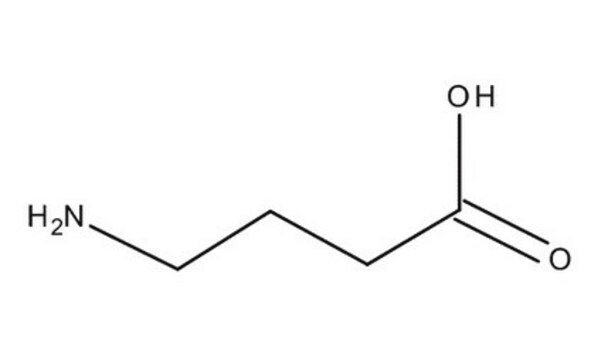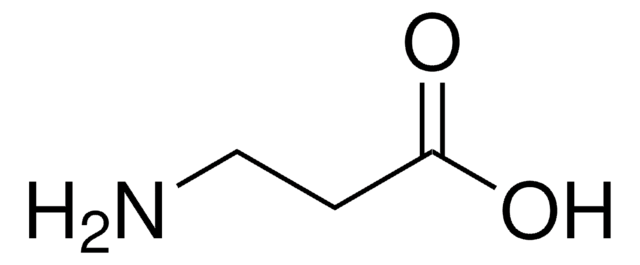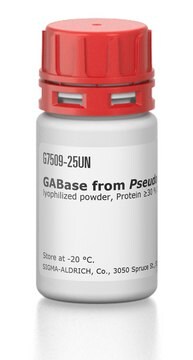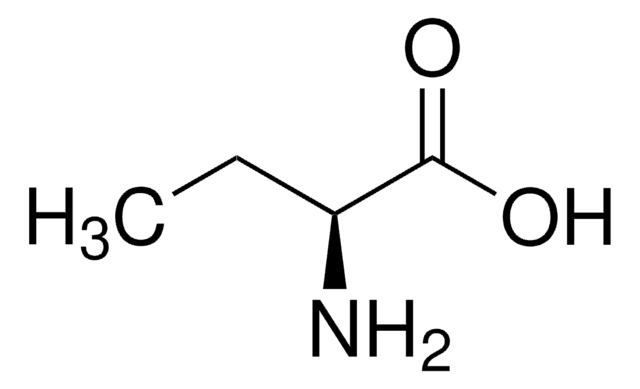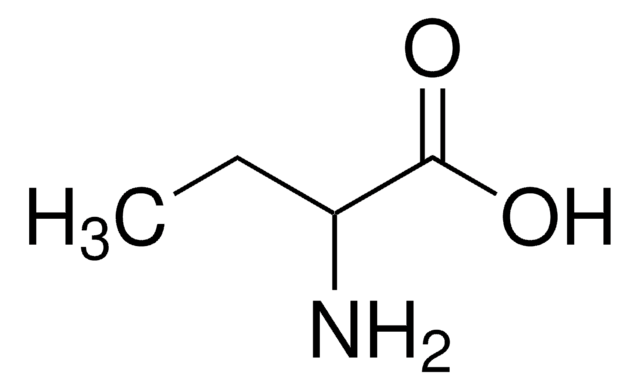Key Documents
A2129
γ-Aminobutyric acid
≥99% (TLC), powder or crystals, inhibitory neurotransmitter
Synonim(y):
GABA, Gammalon, gamma-Aminobutyric acid, 3-Carboxypropylamine, 4-Aminobutanoic acid, Piperidic acid, Piperidinic acid
About This Item
Polecane produkty
product name
γ-Aminobutyric acid, ≥99%
Poziom jakości
Próba
≥99%
Postać
powder or crystals
warunki przechowywania
(Tightly closed. Dry.)
kolor
colorless
mp
195 °C (dec.) (lit.)
rozpuszczalność
water: 50 mg/mL, clear, colorless
ciąg SMILES
NCCCC(O)=O
InChI
1S/C4H9NO2/c5-3-1-2-4(6)7/h1-3,5H2,(H,6,7)
Klucz InChI
BTCSSZJGUNDROE-UHFFFAOYSA-N
informacje o genach
human ... GABBR1(2550) , GABBR2(9568) , GABRA1(2554) , GABRA2(2555) , GABRA3(2556) , GABRA4(2557) , GABRA5(2558) , GABRA6(2559) , GABRB1(2560) , GABRB2(2561) , GABRB3(2562) , SLC6A1(6529) , SLC6A11(6538) , SLC6A12(6539)
rat ... Gabbr1(81657) , Gabra1(29705) , Gabra2(29706) , Gabrb2(25451) , Gabrg2(29709) , Slc6a1(79212) , Slc6a12(50676)
Szukasz podobnych produktów? Odwiedź Przewodnik dotyczący porównywania produktów
Opis ogólny
Research area: Neuroscience
Zastosowanie
- in the preparation of GABA–BSA (bovine serum albumin)–GA (glutaraldehyde) conjugate, which is used as a control for GABA immunostaining
- in the macromolecule suppressed detection of GABA by magnetic resonance spectroscopy (MRS)
- in the intraintestinal application of GABA in order to increase intraluminal fluid secretion
Działania biochem./fizjol.
GABAergic neurons involve myorelaxation, anxiolytic treatment, sedation, and anesthetics. GABA can also influence heart rate and blood pressure.
GABA improves plasma concentration, growth hormone, and protein synthesis in the brain. It also plays a role in reducing blood pressure in humans. GABA acts as a potent hypotensive, diuretic, and antidiabetic agent. It also regulates serum lipids levels and the sensation of pain.
produkt powiązany
przeciwciało
Kod klasy składowania
11 - Combustible Solids
Klasa zagrożenia wodnego (WGK)
WGK 1
Temperatura zapłonu (°F)
Not applicable
Temperatura zapłonu (°C)
Not applicable
Środki ochrony indywidualnej
dust mask type N95 (US), Eyeshields, Gloves
Certyfikaty analizy (CoA)
Poszukaj Certyfikaty analizy (CoA), wpisując numer partii/serii produktów. Numery serii i partii można znaleźć na etykiecie produktu po słowach „seria” lub „partia”.
Masz już ten produkt?
Dokumenty związane z niedawno zakupionymi produktami zostały zamieszczone w Bibliotece dokumentów.
Klienci oglądali również te produkty
Produkty
Profesor Rivnay (Northwestern University, USA) omawia wykorzystanie organicznych mieszanych przewodników jako alternatywy dla skutecznego połączenia jonowego świata biologii ze współczesną mikroelektroniką.
Professor Rivnay (Northwestern University, USA) discusses using organic mixed conductors as an alternative to efficiently bridge the ionic world of biology with contemporary microelectronics.
Nasz zespół naukowców ma doświadczenie we wszystkich obszarach badań, w tym w naukach przyrodniczych, materiałoznawstwie, syntezie chemicznej, chromatografii, analityce i wielu innych dziedzinach.
Skontaktuj się z zespołem ds. pomocy technicznej




